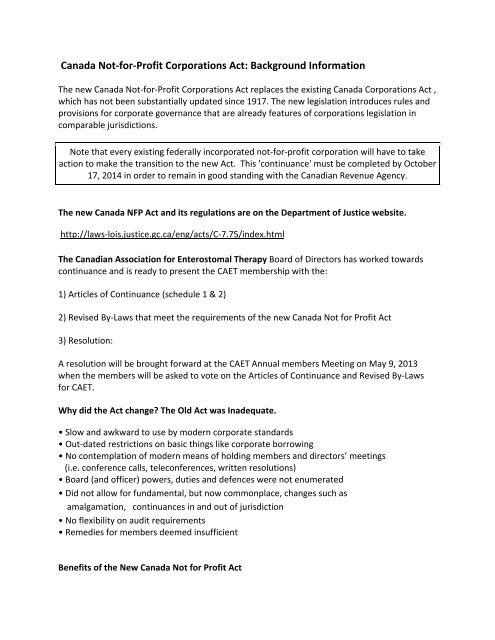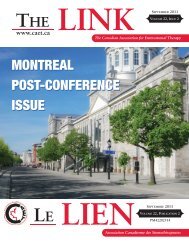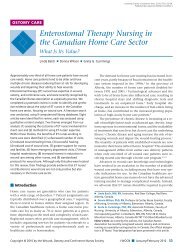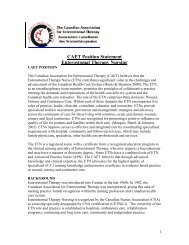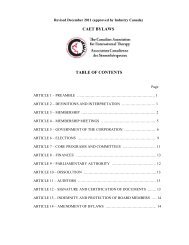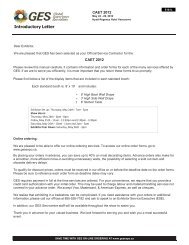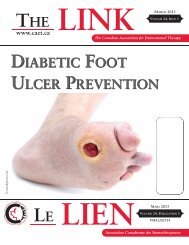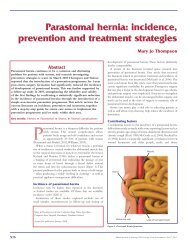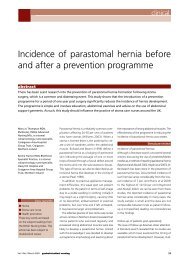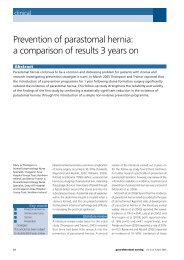New Canada Not for Profit Act Backgrounder - The Canadian ...
New Canada Not for Profit Act Backgrounder - The Canadian ...
New Canada Not for Profit Act Backgrounder - The Canadian ...
- No tags were found...
Create successful ePaper yourself
Turn your PDF publications into a flip-book with our unique Google optimized e-Paper software.
<strong>Canada</strong> <strong>Not</strong>‐<strong>for</strong>‐<strong>Profit</strong> Corporations <strong>Act</strong>: Background In<strong>for</strong>mation<strong>The</strong> new <strong>Canada</strong> <strong>Not</strong>‐<strong>for</strong>‐<strong>Profit</strong> Corporations <strong>Act</strong> replaces the existing <strong>Canada</strong> Corporations <strong>Act</strong> ,which has not been substantially updated since 1917. <strong>The</strong> new legislation introduces rules andprovisions <strong>for</strong> corporate governance that are already features of corporations legislation incomparable jurisdictions.<strong>Not</strong>e that every existing federally incorporated not‐<strong>for</strong>‐profit corporation will have to takeaction to make the transition to the new <strong>Act</strong>. This 'continuance' must be completed by October17, 2014 in order to remain in good standing with the <strong>Canadian</strong> Revenue Agency.<strong>The</strong> new <strong>Canada</strong> NFP <strong>Act</strong> and its regulations are on the Department of Justice website.http://laws‐lois.justice.gc.ca/eng/acts/C‐7.75/index.html<strong>The</strong> <strong>Canadian</strong> Association <strong>for</strong> Enterostomal <strong>The</strong>rapy Board of Directors has worked towardscontinuance and is ready to present the CAET membership with the:1) Articles of Continuance (schedule 1 & 2)2) Revised By‐Laws that meet the requirements of the new <strong>Canada</strong> <strong>Not</strong> <strong>for</strong> <strong>Profit</strong> <strong>Act</strong>3) Resolution:A resolution will be brought <strong>for</strong>ward at the CAET Annual members Meeting on May 9, 2013when the members will be asked to vote on the Articles of Continuance and Revised By‐Laws<strong>for</strong> CAET.Why did the <strong>Act</strong> change? <strong>The</strong> Old <strong>Act</strong> was Inadequate.• Slow and awkward to use by modern corporate standards• Out‐dated restrictions on basic things like corporate borrowing• No contemplation of modern means of holding members and directors’ meetings(i.e. conference calls, teleconferences, written resolutions)• Board (and officer) powers, duties and defences were not enumerated• Did not allow <strong>for</strong> fundamental, but now commonplace, changes such asamalgamation, continuances in and out of jurisdiction• No flexibility on audit requirements• Remedies <strong>for</strong> members deemed insufficientBenefits of the <strong>New</strong> <strong>Canada</strong> <strong>Not</strong> <strong>for</strong> <strong>Profit</strong> <strong>Act</strong>
• Clearer, more modern set of rules to govern the internal affairs of not‐<strong>for</strong>‐profitcorporations• Similar in many respects to rules governing business corporations• Simplified processes• More flexibility, including ability to make fundamental changes such as amalgamations,continuance, etc. (previously not permitted)• More suited to the current needs of the not‐<strong>for</strong> profit sectorHere is a summary of important changes to the CAET Articles of Continuance and By Laws:1) <strong>The</strong> CAET name has been added in the French language to the Articles of Continuance2) Articles of Continuance: See Schedule 11) CAET Purpose<strong>The</strong> CAET’s purpose has been updated from the original “Letters Patent”. <strong>The</strong> CAET is anot <strong>for</strong> profit association but also a “Registered Charity” and so must remain focused onEnterostomal <strong>The</strong>rapists and the Public they serve as follows:Articles of Continuance Schedule 21) <strong>The</strong> CAET must ensure that all finances are focused towards furthering the purpose ofthe association and will not be used <strong>for</strong> the financial or any other ‘gain” <strong>for</strong> its members.This means that the any profits over and above expenses from any initiative, e.g., acourse offered by the CAET Academy, are used to further the purposes of theassociation/pay the costs of another project that will benefit the members , e.g., CAETunderwrote the costs of development of ET nurse competencies necessary <strong>for</strong>certification.2) Under the new ACT, the CAET Board has the power to appoint up to 1/3 of theDirectors between Annual Members Meetings, giving the board the opportunity tofill vacant positions without an election if one becomes vacant between AnnualMembers Meetings. <strong>The</strong>re will also be a stronger focus on “Skill Set” needed <strong>for</strong>Baord positions and this will allow the Board to make sure that they have skill setrequiredKey Changes Under By‐LawsIn some sections, the bylaws will be less specific than CAET’s previous bylaws. <strong>The</strong>sespecifics will be described in Operating Policies which will be easier to update ascircumstances change,e.g. location of the CAET National Office.Section 3 CAET Members3.01 Classes and Conditions of Membership
This Pursuant is essentially to the Articles, a change there of title shall as be under one (1) the class new of act, Members all members in the are Associatio voting n.members. Previously CAET had <strong>Act</strong>ive (voting) members and several additionalcategories of members who were non‐voting.Membership in the Association shall be available to:i)individuals who are Registered Nurses or Retired Registered Nurses who havesuccessfully completed an Enterostomal <strong>The</strong>rapy Nursing Education Programrecognized by the Association; orii )individuals who are not Registered Nurses or Retired Registered Nurses, andwho, prior to 1976, successfully completed an Enterostomal <strong>The</strong>rapy NursingEducation Program recognized by the Association;and who have applied <strong>for</strong> and been admitted into membership, both inaccordance with the Association’s Operating Policies.<strong>The</strong> Association may approve categories of Associates as further described in theAssociation’s Operating Policies. Associates shall not be Members of the Associationand shall have no voting privileges in the Association. Upon payment of the appropriatefee, Associates shall have the privileges set out in the Operating Policies.<strong>The</strong> Associates will include all previous non‐voting member categories:Allied Health Care ProfessionalsAny health care professional interested in and supportive of the objectives of theCorporation. This includes students in CAET's Knowledge to Practice (K2P) programs.IndustryAn individual who is employed by or represents a company whose primary business isrelated to the field of wound, ostomy, and/or continence care, and who is interested inand supportive of the objectives of the Corporation.Student MemberAll students enrolled in the Corporation’s Enterostomal <strong>The</strong>rapy Nursing EducationProgram, with the exception of Industry members, shall automatically becomeStudent members. Industry members admitted to the Program shall retain Industrymember status.Students enrolled in other Enterostomal <strong>The</strong>rapy Nursing Education Programsrecognized by the Corporation may become student members by submitting anapplication and verification of such enrollment.
Students enrolled in basic nursing programs may become student members bysubmitting an application and verification of such enrollment.In the CAET Operating Policies the Membership policy will include continuing theHonorary Life Member process. Honorary Life Members may be Members of the CAETand will include: Every President of the Corporation who has completed at least one (1)full term of office. Any active or retired active member recommended to the Board byanother member and approved by a two‐thirds (2/3) vote at an AMMSection 5.06 Appointment of DirectorsThis was mentioned in the Articles of Continuance. In the CAET By‐Laws you will see thatthere is a provision <strong>for</strong> the appointment of Directors <strong>for</strong> a one year term in order toensure skill set as well as to fill vacant positions between Annual Members Meetings asfollows:Appointment of Directors and TermPursuant to the Articles, following the conclusion of the annual general meeting ofMembers each year, the Board may appoint Directors (the “appointed directors”) tohold office <strong>for</strong> a term expiring not later than the close of the next annual meeting ofMembers. <strong>The</strong> number of appointed Directors shall not exceed one‐third (1/3) of thenumber of directors elected by the Members at the previous annual meeting ofMembers.Directors and OfficersPlease note that “Director” means Director of the Board. <strong>The</strong> 5 Regional Directors of theCAET are considered Directors of the Board and they vote as Board Directors. Officers ofthe CAET include the President, President Elect, Past President, Treasurer, Secretary andExecutive Director. All Officers are also “Directors” who have a vote and are a part ofthe CAET Board except the Past President and the Executive Director who while they fillthe role of an “Officer” do not vote as Board Members.Additional Summary of the <strong>New</strong> <strong>Canada</strong> <strong>Not</strong> <strong>for</strong> <strong>Profit</strong> <strong>Act</strong>Following are some of the key features of the <strong>Act</strong>, as described in the Legislative Summary :
<strong>The</strong> <strong>Act</strong> gives not‐<strong>for</strong>‐profit corporations the rights to buy and sell property, makeinvestments, borrow money and issue debt obligations. Procedures <strong>for</strong> amalgamation, continuance, liquidation and dissolution are set out in the<strong>Act</strong>. Bylaws and amendments must be submitted to Industry <strong>Canada</strong> after members haveapproved them. Industry <strong>Canada</strong> does not review or approve them, but simply acts asa repository. Soliciting corporations require a minimum of three directors , at least two of which arenot officers or employees of the corporation or its affiliates. <strong>The</strong> <strong>Act</strong> specifies financial reporting requirements <strong>for</strong> not‐<strong>for</strong>‐profit corporations,depending on their status as either a soliciting or non‐soliciting corporation and onthe amount of revenue they earn:o soliciting corporations with gross annual revenues higher than $250,000 mustbe audited; where revenues are between $50,000 and $250,000, an audit isrequired, unless the members resolve to have a review engagement; whererevenues are $50,000 or less, a review engagement is required, unless theomembers resolve not to have one;All not‐<strong>for</strong>‐profit corporations must make their financial statements availableto their members, directors and officers, as well as to Industry <strong>Canada</strong>.Soliciting corporations must make all financial statements publicly available. Directors of not‐<strong>for</strong>‐profit corporations would be subject to the same duty and standardof care as directors of business corporations incorporated under the <strong>Canadian</strong>Business Corporations <strong>Act</strong>. <strong>Not</strong>‐<strong>for</strong>‐profit corporation directors would have an explicitduty to act honestly and in good faith with a view to the best interests of thecorporation, and to exercise the care, diligence and skill of a reasonably prudentperson. Failure to abide by this duty and standard could result in liability <strong>for</strong>negligence. <strong>The</strong> bill also provides directors with a "due diligence" defence againstpotential liabilities. Members would be permitted to examine and take extracts of corporate records (mostimportantly, the financial statements); access membership lists (subject to certainrestrictions); and request a meeting and make proposals <strong>for</strong> discussion at the annualmeeting.


